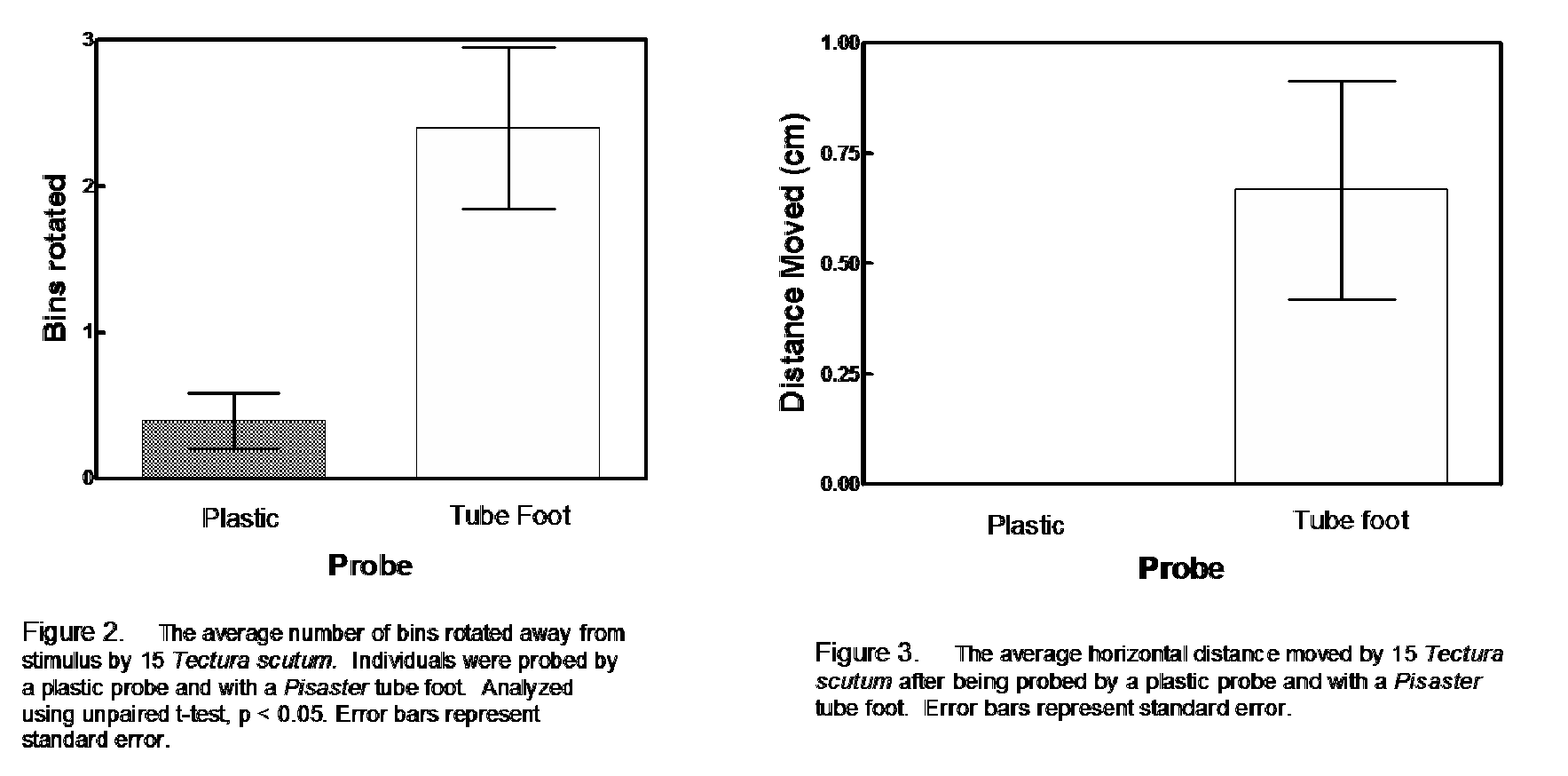Tectura scutum (Rathke, 1833)
Common name(s): Plate limpet, Pacific plate limpet
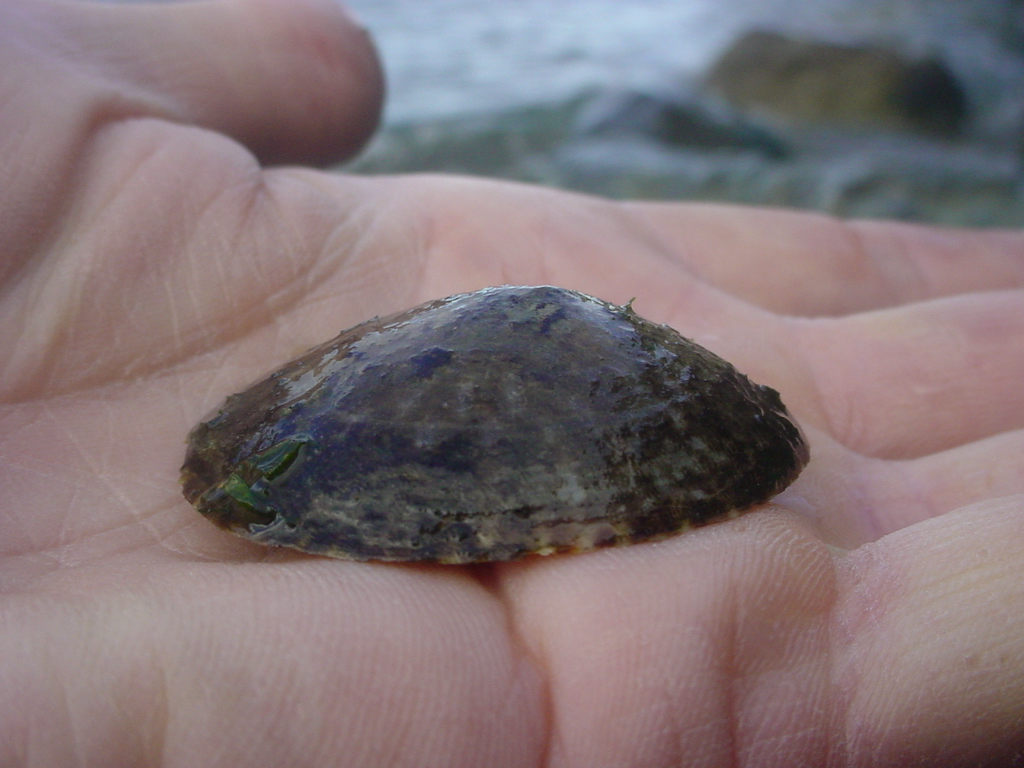
Class Gastropoda
Subclass Prosobranchia
Order Patellogastropoda
Suborder Nacellina
Family Lottiidae
Tectura scutum (Rathke, 1833)Common name(s): Plate limpet, Pacific plate limpet |
|
| Synonyms: Acmaea scutum, Acmaea patina, Acmaea testudinalis scutum, Acmaea tesselata, Notoacmea scutum |  |
| Phylum Mollusca
Class Gastropoda Subclass Prosobranchia Order Patellogastropoda Suborder Nacellina Family Lottiidae |
|
| Tectura scutum shell from Sares Head, WA. Limpet was eaten by a black oystercatcher. | |
| (Photo by: Dave Cowles Sept 2005) | |
How to Distinguish from Similar Species: This is the flattest of the limpets found in this area. It is also larger than most other limpets. It looks most similar to Tectura persona, which is taller and has a convex slope behind the apex. This species looks very similar to the Atlantic species Notoacmea (Tectura?) testudinalis, and was previously thought to be a subspecies of that species.
Geographical Range: Aleutian Islands, Alaska to Baja California, Mexico; rare (or absent) south of Point Conception, CA. Records from south of Point Conception may actually be Collisella limatula.
Depth Range: Intertidal and shallow subtidal
Habitat: Rocky shores, protected from strong wave impact
Biology/Natural History: Grazes on microalgae and coralline algae. Predators include shore crabs, clingfish, the seastars Leptasterias hexactis, Pisaster ochraceous, Evasterias troschelii, and Pycnopodia helianthoides. The limpet crawls rapidly away and may slowly shake its shell from side to side when it encounters one of its predator seastars. Near Rosario this limpet is eaten by the black oystercatcher but to a lesser extent than is Tectura persona, perhaps because its flat shape makes it difficult to dislodge by pecking. It is said to move up and down with the tide, and I have observed that it seems to be more out in the open at night than during the day. The limpet does not seem to home to a particular place on the rock. When submerged they move upward, but more slowly if there is light coming from above. In some places, the smaller limpets are found higher in the intertidal than are larger individuals. Respiration is through the gill and mantle, with the mantle being especially important when the animal is exposed at low tide. The radula of this species is unusual. It is twice as long as the shell (although only the front end is used). The posterior end of the radula responds weakly to a magnetic field. Juvenile amphipods Hyale grandicornis are often found in the pallial groove of this species. Sexually mature and "ripe" females have a purple spot in the center of the foot, while "ripe" males have a white line to the left of the middle of the foot. Spawning occurs from April to June in Washington.
| Return to: | |||
| Main Page | Alphabetic Index | Systematic Index | Glossary |
General References:
Brusca
and Brusca, 1978 (as Notoacmea scutum)
Carefoot,
1977 (As Notoacmea scutum
Harbo,
1997
Harbo,
1999
Johnson
and Snook, 1955 (as Acmaea scutum patina)
Kozloff,
1993
McConnaughey
and McConnaughey, 1985 (as Notoacmea scutum)
Morris,
1966 (as Acmaea testudinalis scutum)
Morris
et al., 1980 (as Notoacmea scutum)
Niesen,
1994 (as Notoacmea scutum)
Niesen,
1997
O'Clair
and O'Clair, 1998
Ricketts
et al., 1985 (as Notoacmea scutum)
Sept,
1999
Scientific Articles:
Bullock, T.H., 1953. Predator recognition and escape responses
of some intertidal gastropods in the presence of starfish. Behavior
5: 130-140
Web sites:
A student study at Rosario by Pick and Reiswig (2007) found that the
black oystercatchers Haematopus bachmani nesting on Northwest Island
are being selective in the limpets they capture. Although Lottia
digitalis was the most common limpet found in intertidal transects
on Northwest Island and were the species found at the highest tide levels
so they should have been more available than any other species, they were
not the most abundant in shell middens found near the oystercatcher nesting
and feeding site. The oystercatchers selected Lottia digitalis
less often than expected, and those they did select were near the maximum
size range found in the intertidal. The oystercatchers seemed to
prefer other, larger limpet species such as Tectura persona, Tectura
scutum, and Lottia pelta, all of which were found by chi-squared
analysis to be in significantly higher numbers in the midden than expected
from the intertidal abundance. Whether this selection by the oystercatchers
is due to a specific selection of species or simply a selection of the
largest individuals present in the intertidal is not known.
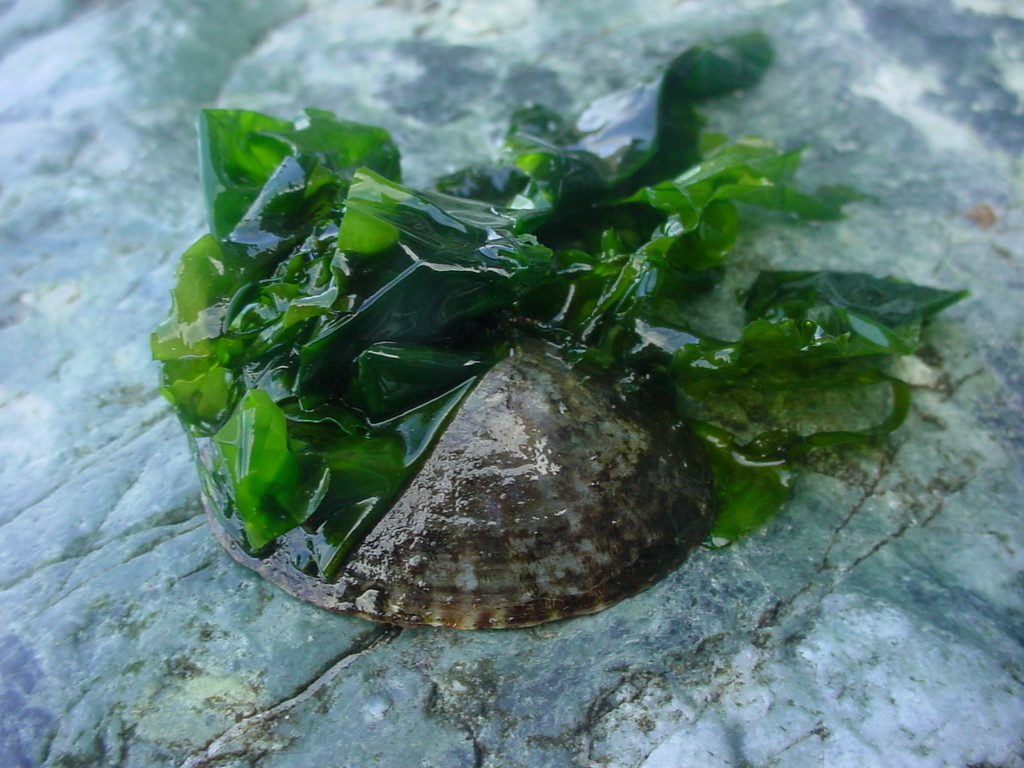
Algae such as this Ulva may attach to Tectura scutum
shells. Photo by Dave Cowles Sept 2005
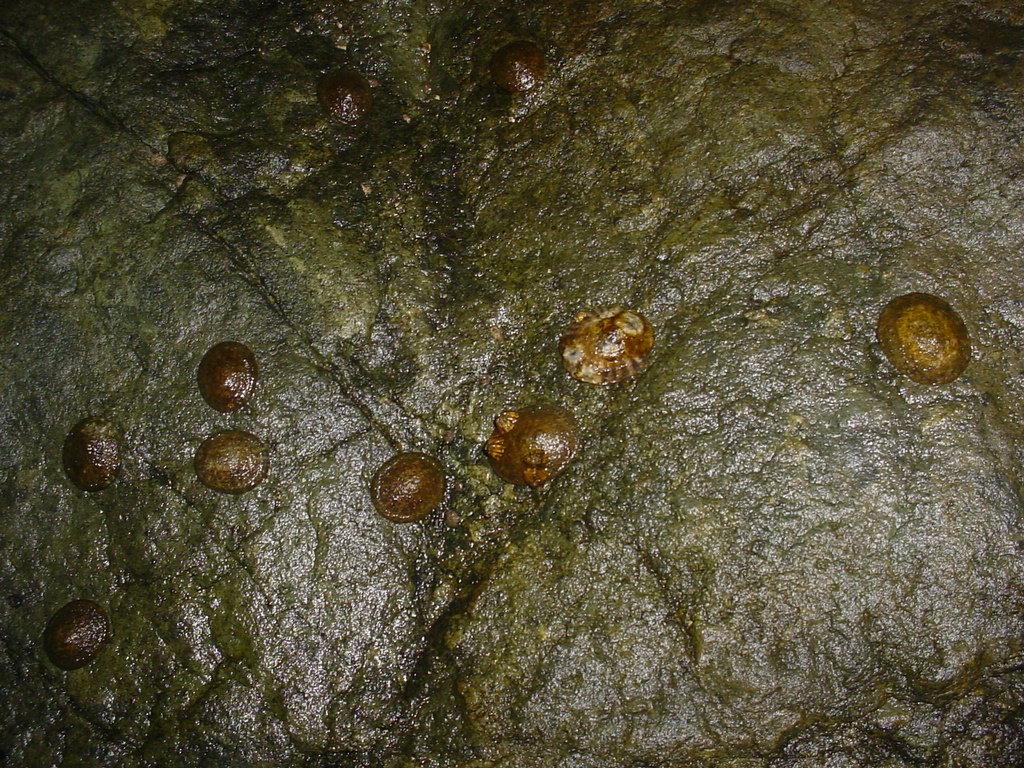
Tectura scutum actively forage across the rock surfaces at night.
Photo by Dave Cowles, Sept 2005
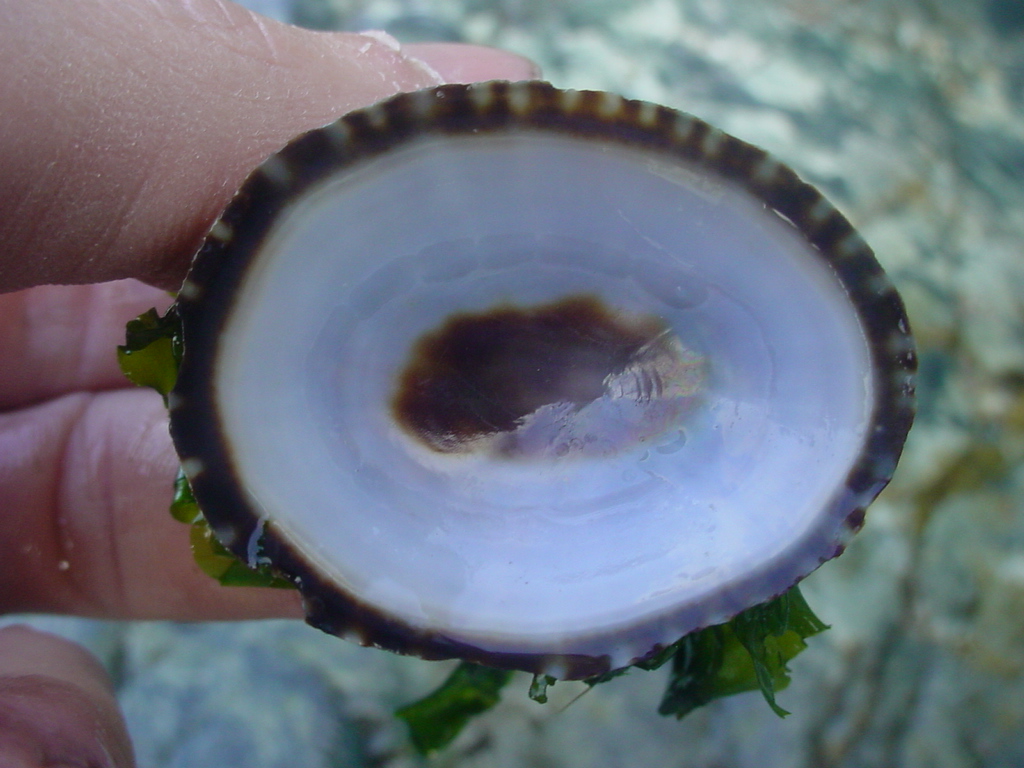
The inside of the shell has a dark blotch at the apex and a dark, often
speckled band around the edges. Note that in this view the C-shaped
mantle scar is visible, with the opening for the head to the right.
Photo by Dave Cowles, Sept 2005
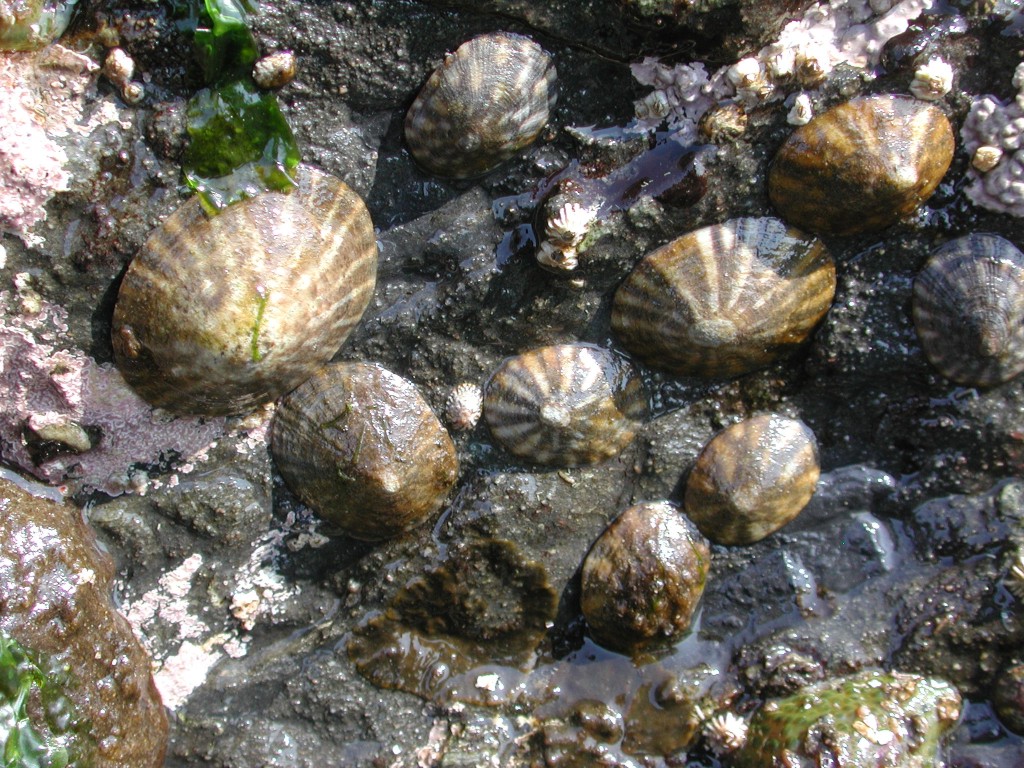
These individuals are aggregated in a shallow depression on the vertical
surface of an intertidal rock. Photo by Dave Cowles, July 2007
Another 2007 student paper, by Rachel Kim, Janene Michaelis, and Lisa
Hainey, investigated the response of T. scutum to smell of or contact
with a tube foot from Pisaster
ochraceus. The limpets did not show any significant increase
in movement (crawling up the sides of the aquarium) when placed in water
that had been in contact with P.
ochraceus. However, touching one of the limpet's tentacles
with a tube foot from P.
ochraceus elicited a strong response--the limpets rapidly turned
away from the point of contact and crawled rapidly away. The two
graphs below show this effect (variability in the distance moved is large
enough that the effect is not significant, but the 45 degree bins rotated
from point of contact is significant). Click
here for a time-lapse movie by Lisa Hainey which shows the rapid escape
response of the limpet when contacted.
